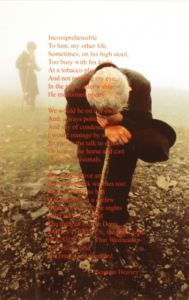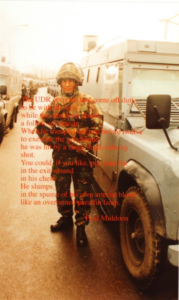CULTURE & CONFLICT: THE NORTH OF IRELAND, CEPA Gallery, Buffalo, NY
As the final chapter of British withdrawal from it’s last vestige of empire is played out in Ireland (Britain’s oldest colony and most intractable problem) a transition from armed combat to political engagement has occurred. The conflict between Britain and Ireland has always involved a struggle for the hearts and minds of public opinion with art and culture functioning as a primary contested space for the opposing parties in this now centuries old war. Art and culture play such a central role because they are employed by the parties to this conflict as key instruments of persuasion, for, as Pablo Picasso stated to Simone Tery in 1945; “Art is not made to decorate apartments, it is an offensive and defensive instrument of war against the enemy.” Art is an obviously subjective information system that echoes it’s maker’s measure of reality with the potential to shape a viewer’s understanding of their world.
Despite the fact that we supposedly live in a “global village” created by a revolution in electronic information technologies, the reality is that the vast majority of this purportedly objective and unbiased information is subject to “spin” and “disinformation,” all tailored to steer public opinion and manufacture consent. The political stakes of maintaining the status quo has transformed information into a weapon. Because of this, the conflict in the North of Ireland is most often represented in the American media as either a manifestation of “Sectarian Struggle” a kind of quaint vestigial survival of the religious wars of the 17th Century, or more frequently, as “Terrorism” a term which places these events within the context of inexplicable violence perpetrated by mysterious forces of evil thus simultaneously obscuring and trivializing Ireland’s actual relationship with Britain. This disinformative oversimplification is aimed at portraying the conflict as inexplicable and therefore irrelevant to American life. Describing the strife in the North as “Sectarian” is about as accurate as referring to the Vietnam War as a conflict between Christians and Buddhists. The reality is that this is a political and not a theological dispute.
Often overlooked in this country is the ultimate responsibility that Britain bears for the protracted violence in the North. Now committed to a political solution, the Nationalist community has agreed to take steps toward the eventual decommissioning of its paramilitary the Provisional Irish Republican Army. It should be noted that the Loyalist community has made no such concessions and its paramilitary forces such as the Loyalist Volunteer Force and the Ulster Freedom Fighters remain actively committed to wrecking the fragile peace accord that has only just barely survived their intransigent resistance. This accord is aimed at establishing a democratic power-sharing government that would integrate all of the citizens of Northern Ireland regardless of their political or religious orientation. What is at stake here is a fundamental change in the power structure that has dominated the North of Ireland for centuries: an end to Loyalist privilege granted by Britain in exchange for their service as a proxy force defending British colonial interests and a beginning of political representation and fair play for Nationalists after centuries of oppression.

